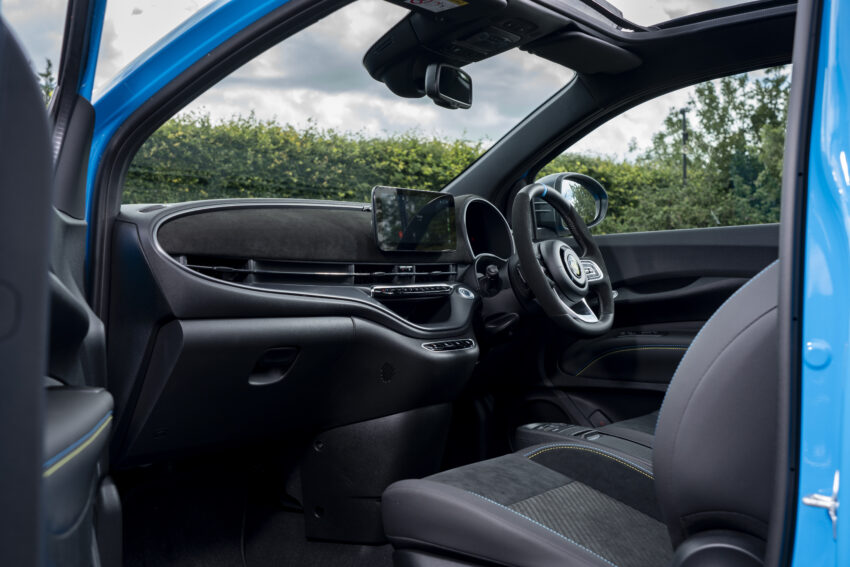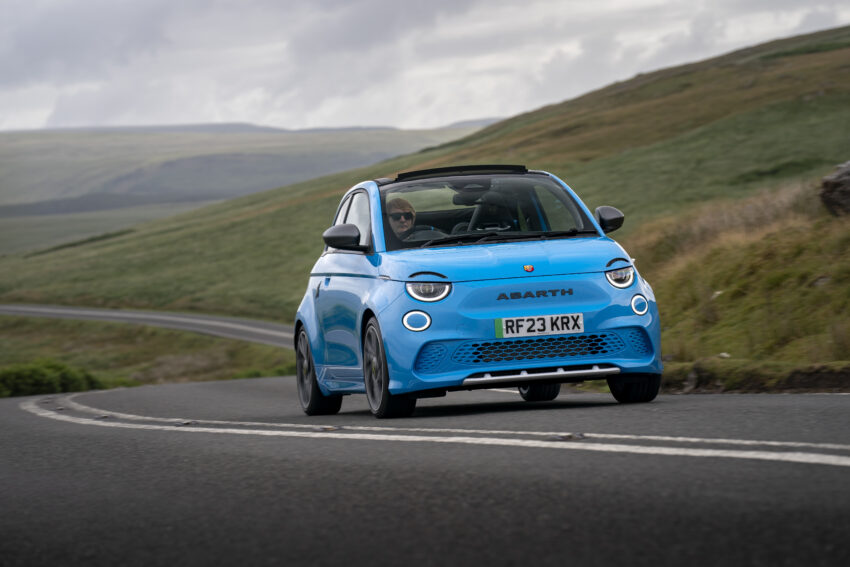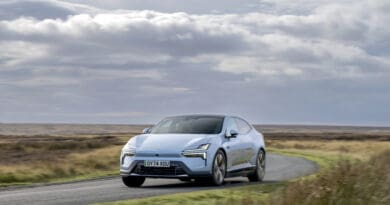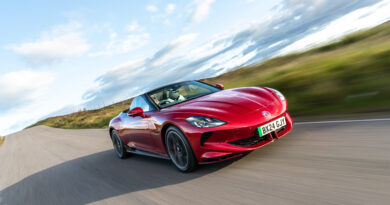Abarth 500e Convertible: Electric Fiat with added fizz
The Abarth 500e proves that small EVs don’t have to be dull
It’s sometimes said that all electric cars are a bit boring and a bit samey. Those of us who drive them regularly already know that’s not true but sometimes it helps to have a car come along and emphatically prove that isn’t the case.
A car like the Abarth 500e, for example.
This is the first EV from Fiat’s in-house tuning specialist and it takes the regular Fiat 500e and makes it a whole lot sillier and a lot more fun as it looks to challenge the Mini Cooper SE in the world of small electric hot hatches.
Design, interior and technology
Straight from the off, the Abarth 500e makes its intentions clear. It takes the basic 500e – already a sharply designed thing – and gives it just enough extra muscle without overdoing it. It has a 6cm wider track, deep front and rear bumpers with white highlights and thick side skirts with Abarth pressed into them. The luminous yellow scorpion badges on the rear wings and wheel centres are playful eye-catching touches and the vibrant Poison Blue of my test car tops it all off to make sure you’ll get noticed.
Inside, there are more scorpions, this time on the pedals, embossed in yellow into the headrests of the sports seats and, in larger form, across the seats themselves. The seats and dashboard in my Turismo-spec car were finished in Alcantara instead of lower-spec leather and there are body-coloured fabric pulls to move the front seats forward.
There’s not much point in doing that, though. It might look bigger (and is fractionally longer), but the Abarth is just as tiny as any other 500e on the inside. Unless your driver and passenger are vertically challenged, the rear seats are more ornamental than functional and the boot is a tiny 185 litres. The front seats have enough room for most drivers and the convertible roof actually improves the headroom stakes marginally, too.

Speaking of the roof, it’s Fiat’s now-famous ragtop approach with a large fabric panel set into the metal of the roof. A touch of a button sends it sliding back towards the bootlid, creating a sort of three-quarter drop-top that lets in the sunshine but protects you from the worst of the wind.
Away from the Abarth styling, the rest of the interior is the same as the regular 500e. That means a neatly designed modern/retro blend with a simple rounded dashboard, which features a panel of drive select buttons and a wireless phone charging slot. Above these, sits a 10.25-inch touchscreen.
The screen uses Fiat’s interpretation of the Uconnect system that’s also in the Jeep Avenger and in contrast to the frustratingly basic Jeep setup, the Abarth’s is frustratingly cluttered with sub-menu after sub-menu. Thankfully there are physical heating controls and wireless Android and Apple mirroring, so you can mostly avoid the system’s idiosyncrasies.
Battery, motor and performance
While the regular Fiat 500e makes do with either a 94bhp or 116bhp bhp motor, Abarth has retuned that to produced 152bhp and 173lb ft.
In a world where even regular family cars now produce in the region of 300bhp that’s not a lot but the Abarth is small, (relatively) light, and puts fun ahead of flat-out pace.
Its 0-62mph time of 7 seconds is similar to many big powerful SUVs but Abarth has cleverly adjusted the single-speed transmission to give the throttle more immediate bite. This brings a far more lively and instant response than the on-paper figures suggest. The little ‘in-between’ places, such as coming on throttle after a corner, are where it feels quickest – it’ll go from 25-37mph, or from 37mph-62mph a second quicker than the 178bhp petrol Abarth 695.
There are three driving modes and while Turismo caps the motor’s output at 134bhp/162lb ft the two Scorpion modes – street and track – unlock all of it. They also bring changes to the traction control and steering weight. Street retains the Turismo’s one-pedal driving function. while track disables this for a more old-school two-pedal approach. It works well in this setting. The brakes bite firmly without being snatchy and there’s a clean progression between regen and friction braking that gives a positive linear feel.

As well as making the car wider, Abarth has actually stretched the wheelbase by 24mm in search of handling improvements and, on the whole, it’s been successful. The longer, wider platform gives a planted base, which allows you to make the most of the quick, responsive handling. Despite some obviously fake electric ‘weight’, the steering does a decent job of providing direct, accurate responses and feedback. You can fling the Abarth into a corner with vigour, confident that you know how it’s going to react.
That sharp handling and lively throttle combine to create a car that fizzes along the road just like its petrol forebears.
If you want to take that petrol-like quality a step further you can activate the Abarth Sound Generator which replicates the sound of an ICE Abarth. You can activate it but that doesn’t mean you should.
The bassy rumble it makes at idle is funny for about five seconds and the tone rises in line with increased speed as you’d expect, but at a cruise it becomes a persistent dull drone that quickly gets irritating (a bit like a petrol Abarth). Thankfully, you can turn it off.
Unlike most petrol Abarths, the 500e rides acceptably. The combination of firm suspension and short wheelbase means still it fidgets like a hyperactive toddler but it is slightly more forgiving than its brutal predecessors. In the context of a nippy little hot hatch it’s perfectly acceptable.
Abarth claims3.4m/kWh and a range of between 150 and 164 miles from the 42kWh battery, depending on the trim level. I can’t tell you what I actually achieved because the car displays its efficiency in miles-per-gallon-equivalent, which is as helpful as a chocolate fireguard. What I do know is that on a 100% charge, the trip computer claimed I’d get 140 miles of range. Drive it enthusiastically, as you’ll want to, and you’ll probably see even less than that.
That’s really not a lot, especially when the equally fun Mini Cooper will return closer to 200.
Price and specification
What is a lot is the Abarth 500e’s list price. The car I drove – a convertible model in Turismo spec costs £41,195 before you add £600 for the eye-catching paint.
You can bring that down to the entry level £34,195 by ditching the fabric roof and avoiding the Turismo spec. The hardtop is £3,000 cheaper and going for the entry grade saves £4,000 but downgrades the wheels from 18 to 17 inches, and loses the heated seats, keyless entry, 360-degree parking camera and wireless phone charging, along with the alcantara upholstery and blind spot detection.
Verdict
Realistically, it’s hard to justify the Abarth’s price when you can pick up a second hand Porsche Taycan for less.
But Abarths have never been about value. They have always been expensive for what they are and compromised in one way or another. They’re an indulgence or a toy but for some people such indulgence is worth the price and thanks to its punchy looks and lively drive, the 500e is a worthy addition to the Abarth lineage.

Abarth 500e Convertible Turismo
- Price: £41,195 (£41,795, as tested)
- Powertrain: single-motor, front-wheel-drive
- Battery: 42kWh
- Power: 152bhp
- Torque: 173lb ft
- Top speed: 96mph
- 0-62mph: 7 seconds
- Range: 150 miles
- Consumption: 3.4m/kWh
- Charging: up to 85kW






